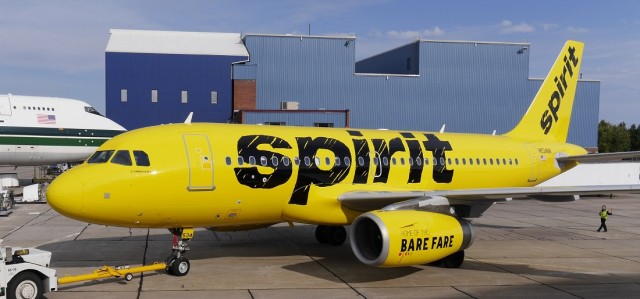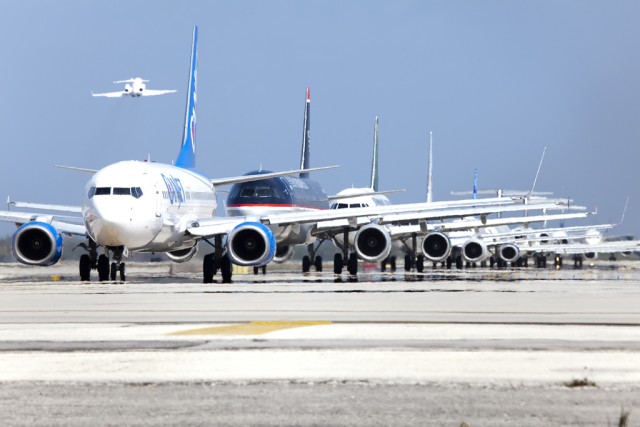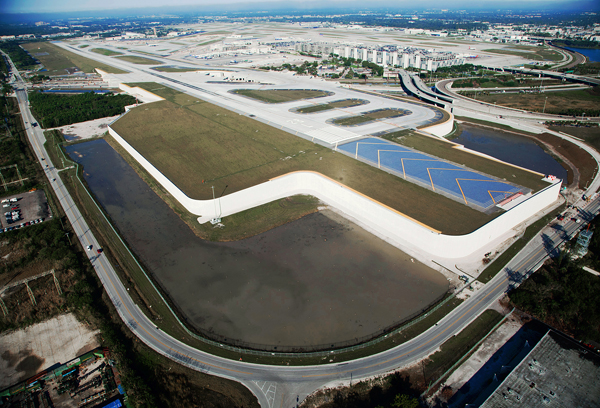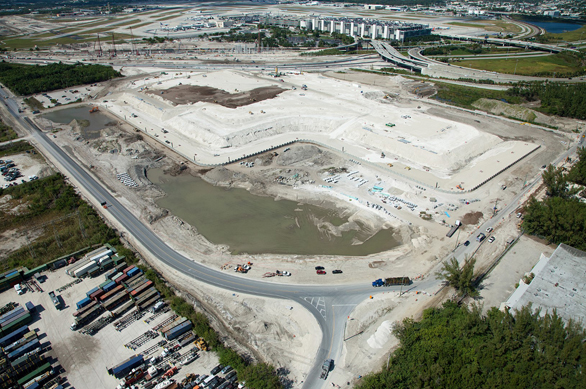Although Fort Lauderdale Hollywood International Airport (FLL) is a mere 21 miles north of its huge cousin, Miami International Airport (MIA), it’s worlds apart in its focus and business model. FLL is a hub for low-cost carriers (LCCs) and ultra-low-cost carriers (ULCCs), and funnels passengers to nearby Port Everglades, one of the busiest cruise ship terminals in the world. In 2014, FLL saw almost 25 million passengers use its facilities, led by ULCCs and LCCs Allegiant, JetBlue, Southwest, Virgin America, and Spirit, which is based at FLL.
Trans-Atlantic LCC, Norwegian Air Shuttle, also serves FLL with Boeing 787s. A number of U.S., Canadian, and Latin American airlines also provide non-stop scheduled service to FLL, along with seasonal charter carriers.
’œWe complement MIA,’ says Allan Siegel, FLL’s Community Outreach Coordinator. ’œBut our landing fees are lower, so our airlines are saving significant costs. That makes us attractive to the LCCs, and in 2014, LCCs handled 62% of our total traffic.’ The airport’s traffic has grown steadily, up 25% in 10 years, but that growth led to capacity issues, driven by FLL’s configuration.
The airport is on a relatively small chunk of land, at least for an airport. It’s hemmed in on all sides by highways, a railway, and a residential area. The original runway layout had the longest runway, 9,000 foot 09R/27R to the north of the passenger terminals. Parallel runway 09R/27L, along the south side of the airport, was only 5,300 feet long; too short for airline operations. The two runways were intersected by crosswind runway, 13/31, which was under 7,000 feet long. That configuration effectively turned FLL into a single-runway operation, with virtually all airline operations using 09L/27R. The maximum capacity was 84 operations per hour.
With traffic growth continuing, the FAA estimated that the average flight delay would be 24 minutes, if nothing changed at FLL. ’œWe wanted to keeps delays to a minimum. So the decision was made to rebuild and extend the southern parallel runway to 8,000 feet, which would handle the majority of the airlines’ fleets in the coming years,’ says Siegel.

To add some flare to FLL, Spirit, which is based at the airport, recently sported a new, bright livery – Photo: Spirit Airlines
With the western threshold of the new runway remaining in the same place as the old threshold, the new, half-mile eastern extension needed some remarkable engineering. The new runway intersected with the existing north-south highway and railway. Re-routing or burying the road and rail corridor wasn’t an option. Instead, the runway goes over the corridor. A huge, 60-foot high, 6.5 million-yard earthen embankment was created on either side of the highway and railway. Directly over the corridor, massive runway and taxiway support structures were built.
The structures used over 2,600 two-foot wide concrete piles, almost 70,000 cubic yards of concrete, and at 15.5-inches thick, the runway deck can handle the landing impact of a fully-loaded Airbus A380 or Boeing 747-8. The old portion of the runway was completely rebuilt to the strength standards of the new section, and the new runway has an average grade of 1% along its 8,000-foot length. The western threshold is at ten feet above sea level, while the eastern threshold sits on the new embankment, at 60 feet ASL.
The project began in early 2012, and included the decommissioning of the crosswind runway; new, changed, and closed taxiways; and a new ’œZulu’ ramp area just north of the new runway. To help ensure safety in the case of an aircraft overrun, an Engineered Materials Arrestor System (EMAS) is installed at each end of FLL’s runways. The EMAS is made of crushable material that slows an aircraft, similar to a ’œrunaway lane’ for trucks.
Since it was located in the new ’œrunway protection area,’ the Hilton hotel adjacent to the airport was purchased by FLL, and then demolished. And recognizing the noise impact that the new runway will have on the nearby residential area, FLL has created a Noise Mitigation Sound Insulation program for the over 2,000 units that are affected.
The new runway and taxiways opened in September 2014, and according to FLL’s Alan Siegel, ’œour airlines are happy. Taxi times are reduced, and the airfield’s capacity is now 107 operations per hour. Flights operating from Terminal 3 and 4 use the new south runway, and those to Europe continue to use the north runway, taking advantage of the extra 1,000 feet of length.’ Reflecting the normal movement of the magnetic north pole, FLL’s runways were re-numbered as 10L/28R and 10R/28L, in Fall 2014.
With the runway project complete, improvements are now being made to FLL’s terminals. All four terminals are scheduled for renovation. Terminal 1 will get a new, five-gate Concourse A, and Terminal 4 will be extensively redeveloped and expanded. By the time construction is completed in 2017, FLL will have 66 gates, up nine from the current 57. The overall cost for the runway and terminal project is $2.3 billion, funded by grants, many levels of government and agency contributions, and passenger charges.



Nice piece, Howard! I’ve seen FLL evolve since first moving to South Florida in 1980. I would only add that with recent natural magnetic changes, the runways are now 10L/28R and 10R/28L.
Thanks, Luis! You made a good point, and I’ve updated the story. As a pilot, I should have noticed the change!
Another positive for the new south runway is for those who plane spot. There is a park that is elevated higher than the runway on the west end that allows for great pictures and sight lines. Also it looks strange to see a plane go downhill as it takes off to the west.
There are many different Canadian airlines that use FLL seasonally as it has migrated the Canadian tourists north from Sunny Isles Beach to Hollywood.
The new runway is great but your biggest challenge is the processing of inbound international passengers through the customs and immigration process.
I have arrived on three occasions with Norweigian and stood in line to clear through customs for an unacceptable
period. The immigration seems to be slow but OK but I don’t understand why the need to stand in line for up to 30-45 mins to see the customs guys, never seen this delay anywhere else in the USA unless selected for a secondary inspection.
Any thoughts ?
Dear Martin,
I forwarded your comment to FLL’s Allan Siegel. Here’s his reply:
“We are aware of the challenges in the Customs inspection area and will make the following improvements:
– Six more inspection stations are being placed in the Customs and Border Protection baggage claim area. This allows officers to move passengers more quickly toward the exit.
– In June, U.S. citizens and legal residents can take advantage of Mobile Passport. This is a mobile app that allows travelers to submit passport and customs declaration information via a smartphone or tablet. That will allow them to quickly claim their luggage.
– This summer, automated passport control will be expanded to allow foreign travelers to use kiosks to enter passport information. Currently, only U.S. citizens and legal residents can do so. That will increase the number of travelers who can use automated passport control from about 60 to 90 percent.
– By 2017, the inspection area in Terminal 4 will be remodeled and expanded by 35,000 square feet, doubling its size and capacity. The baggage claim area will triple in size.”
As part of the expansion of Terminal 4, they are building a new ICE facility on the third floor of new Concourse G to replace the temporary trailers that were put in place many years ago. This should speed up the process of both Immigration and Customs. Prior to Spirit and JetBlue starting international operations, most international flights came from countries that had preclearance facilities like the Bahamas and Canada so the use of the facility was minimal.
Also, Terminal 1 will be expanding to a new Concourse A which will be the International Terminal for Southwest Arrivals. It is scheduled to start construction over an existing apron parking area in either late 2015 or early 2016, and should increase the flow of connecting traffic to FLL. This is another example of why WN is becoming more of a legacy than a LCC.
COULD YOU TELL ME IF FLL STILL PLAN TO BUILD THE ELEVATED SUNPORT LIGHT-RAIL SYSTEM THAT WOULD CONNECT THE AIRPORT TO PORT EVERGLADES?
Hi Darrell,
FLL’s Allan Siegel has replied to your question:
“There are no plans to build a light rail system connecting the airport to the port. Several years ago a study was conducted on this topic. The study identified several alternative transportation methods. Because of funding issues, no action is planned at this time.”
thank you very much!!!
oh wow – I wasnt aware of the possibility of a light-rail system that would connect the airport to port everglades…that would have been cool! I’m looking forward to the expansion of the the international terminals; they always get so crowded during the day.
This is great for Fort Lauderdale more tourist to come.